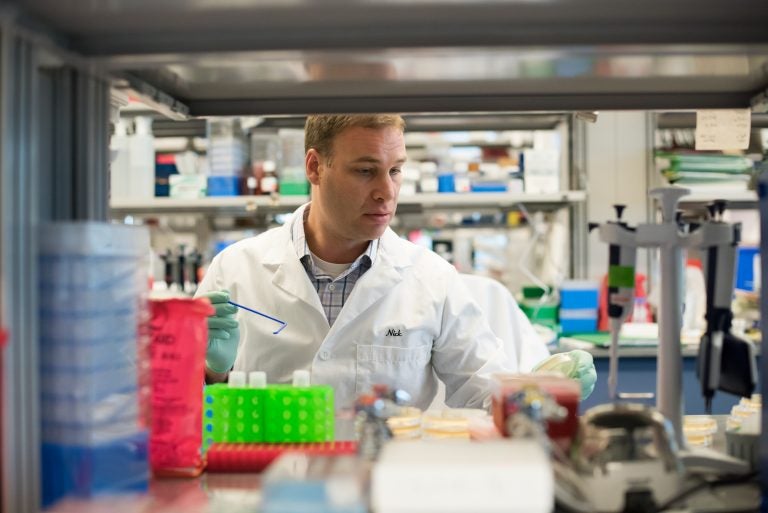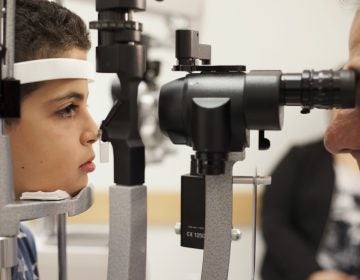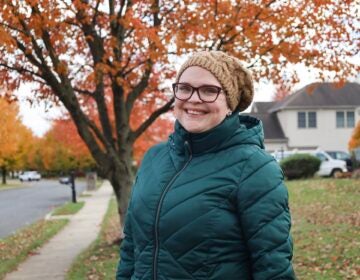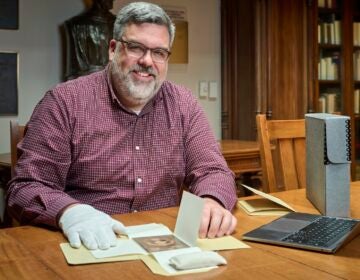Penn researchers develop new gene therapy for previously untreatable eye disorder
The gene therapy comes seven years after another research group at the university helped come up with the first FDA approved gene therapy for an inherited disease.
Listen 1:44
A research scientist in the Spark Therapeutics laboratory (Spark Therapeutics)
From Philly and the Pa. suburbs to South Jersey and Delaware, what would you like WHYY News to cover? Let us know!
Seven years ago, a Philadelphia company and researchers at the University of Pennsylvania made history by developing the first gene therapy approved by the Food and Drug Administration, which treats an inherited disease that destroys cells needed for healthy vision. Now, other Penn researchers have followed up with another gene therapy for a different form of the disease.
Leber’s congenital amaurosis, or LCA, is rare, but is one of the most common causes of blindness in children. It’s estimated to affect two to three out of every 100,000 babies. There is no treatment for patients with a form of the disease called LCA type 1, though researchers have been working on one for more than 20 years.
For patients with LCA type 1, their eyes stop making a particular protein they need to be able to see. The new gene therapy uses a virus grown in a lab to deliver instructions to the eye’s cells, which can then make the missing protein.
Researchers used to think that because patients are born with this condition, the complex molecular machinery beyond the single missing protein may have just stopped working. However, it turns out the gene therapy can help the cells make the protein again, explained Artur Cideciyan, a research professor of ophthalmology at the University of Pennsylvania.
“Within a matter of eight to 10 days, (photoreceptors) turn on and start functioning just like that,” he said. “It was surprising to see that there is this dramatic improvement in the ability to sense light by 10,000 fold or more in a cell that for the previous several decades had been just silent and dysfunctional.”
The researchers published the findings of this early clinical trial in The Lancet medical journal earlier this month. They enrolled 15 patients to conclude that the treatment is safe, and studied how large a dose they should give to patients. There were some side effects, but these came from the eye surgery for the gene therapy and not the gene therapy itself, Cideciyan said.
“None were related to the actual drug that was injected through the surgery. So we concluded that the drug had a manageable side effect profile and was generally safe,” Cideciyan said.
A future clinical trial would measure how effective the treatment is, which is needed for them to submit the treatment for FDA approval. Even though the main purpose of the first clinical trial was not to measure the treatment’s effectiveness, there were some promising findings. For instance, nine patients got a high dose of the therapy and their ability to sense light increased by around a hundredfold.
To explain what this means, Cideciyan said imagine that a patient could previously only see inside a well-lit indoor office environment, and would struggle with any environment that is not as brightly lit. With a hundredfold increase in their ability to sense light, the same person can now see even in the ambient mood lighting of a restaurant.
If the gene therapy works, it would be the first treatment for this condition, said Nieraj Jain, associate professor of ophthalmology at Emory University, who was not a part of the research but sees patients with LCA type 1.
“This is a great development for our field and for patients affected by this rare disease,” Jain said. “You could have individuals who go from really not being able to navigate their environment, or particularly in dimly lit settings, to being able to get around even when the ambient lighting is dim.”
Jain said right now, he and his colleagues can give counseling and support for patients with LCA type 1 to understand how the disease will play out, and connect them with low vision specialists and occupational therapists who can educate them on using visual aids, such as a white navigational cane.
He added that one potential hurdle that this new gene therapy faces is coming up with a measure that the FDA can use to decide how effective the treatment is. He explained that in The Lancet article, the researchers measured what is the dimmest light that a patient can detect, which he says the FDA has traditionally not considered a meaningful outcome they can use to approve a new therapy.
For instance, the team behind Luxturna, the gene therapy that the FDA approved seven years ago, came up with a new measure called a mobility test, which measured how well a patient was able to get through a maze in a lab at different levels of light.
“I can’t speak for (the FDA), but they’re really going after endpoints that are … clinically meaningful,” Jain said. “You can show on a spreadsheet that certain outcome measures are improving, that the statistics look a bit better, but the end result is most important: Is the patient really best served? Are they really deriving a clinically meaningful benefit from this new therapy?”

Get daily updates from WHYY News!
WHYY is your source for fact-based, in-depth journalism and information. As a nonprofit organization, we rely on financial support from readers like you. Please give today.






